Integrated systems drive efficiency and empower teams to work smarter, not harder. When information flows seamlessly across your operations, the payoff is more than time saved—it’s better decisions, faster execution, and fewer surprises. That’s exactly what Texon experienced, and why their story resonates.
Ken Schneider, Manager of NGL Systems at Texon, LP, and Karen Jackson, eONE Product Manager at Quorum, feel Texon’s use of eONE is helping eliminate silos, reduce manual work, and unlock operational visibility—laying the groundwork for other operators to follow.
Building a Connected Foundation with eONE
The eONE platform components work together to eliminate operational silos. Data in eONE flows across modules, making it so integration is no longer a luxury, but essential. Whether dealing with production, revenue, or reporting, the ability to see the full picture in one place simplifies everything from troubleshooting to planning.

Future & Current Integrations
For example, eONE integrations within Texon can be split into two categories: imports and exports, with either configurable or third-party sources. Accounts, Payment, Price, Journal Entry, Location, Transaction are configurable and many more, while integrations include Quorum solutions like FLOWCAL and Quorum TIPS or third-party tools Geometrix, MarketView, NGTL, and many others. On the exports side, configurable integrations include Contract, Payment, Stakeholder, Transaction and others, with Petrinex, Petrotranz and Transport4 on the third-party side. This wide breadth of functionality allows for seamless integration on multiple platforms to centralize data and encourage consistent results.
Reducing Workload and Errors with Smarter Processes
Manual data entry, back-and-forth communications, and mismatched numbers are still common for teams working with disconnected systems. This session outlines how automation through integration not only eliminates those pain points but also frees up teams to focus on higher-value tasks. The result is a more reliable operation where issues are flagged earlier and teams act faster.
Turning Efficiency Gains into Business Results
Integration doesn’t just speed things up—it changes outcomes. eONE users are seeing stronger performance across finance and operations through reduced cycle times and more consistent data. From monthly close to field ticketing, the session highlights tangible improvements that lead to better alignment and faster execution.
Addressing Real Challenges from the Field
At Texon, integrations in eONE are essential to keeping operations balanced and accurate. For example, the team handles offsetting crude deals—buying 5,000 barrels a day from one party and selling to another to manage credit exposure. That only works if both sides of the deal are in the system. To keep data flowing, Texon runs about 100 automated imports daily, work with close to 30 different truck carriers, and there's a lot of data moving around, pulling in carrier run statements, T4 tickets, and meter readings—sometimes just one record, sometimes hundreds. capturing and uploading automatically, date, the barrels in the truck, and the locations, but also the seal on seal off numbers, the unload start time, unload end time, tank numbers, driver name. On top of that, AR/AP manually enters bank payment data, which triggers an automated credit check. If a deal pushes Texon over its limit—like when five extra trucks are booked—the system immediately alerts the credit manager, enabling a quick decision with no manual intervention.
Taking Action Toward a Digital Core
The key takeaway is clear: integration isn’t just an IT upgrade—it’s a strategic move. As companies look to accelerate performance and navigate complexity, connected systems like eONE provide the clarity and control needed to make that possible.
 Previous Page
Previous Page